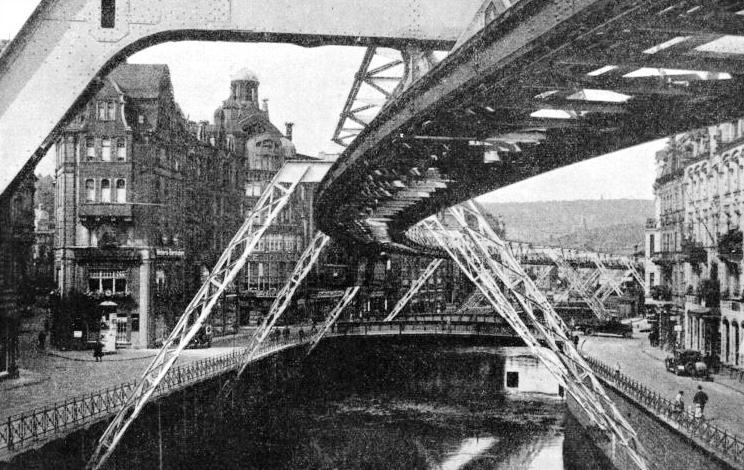
© Railway Wonders of the World 2012-


Elevated and Mono-Railways
Lines that Run Above City Streets
THE BARMEN-
THE elevated railway, which is not to be confused with aerial railways, was intended for short-
From early in its history the railway has gone above ground as well as on the surface. The initial section of the first public railway to enter London -
This method of construction was, in South London, due to two causes. The area was densely populated, and the cost of acquiring land and property to enable the lines to be built on the surface was prohibitive. Further, it was necessary to elevate the tracks to a level at which they could eventually be brought across the Thames to the terminal stations on the north side of the river.
In certain cities there has for many years been a close connexion between the overhead and the underground railways. Part of the “Hammersmith and City” section of the Metropolitan was opened to traffic as early as 1864, only a year after the inauguration of the initial portion of the Metropolitan. A relatively large mileage of this system and of that worked by the Metropolitan District is built on arches, so that London’s Underground employs the three methods of subterranean, surface, and overhead construction.
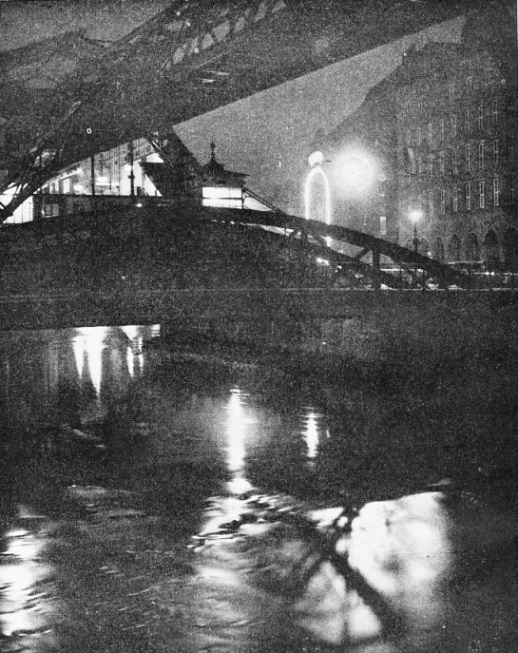
OVERHEAD RAILWAY TRACK passing over a bridge across the Wupper River in Elberfeld, Germany. The line connects the towns of Elberfeld and Barmen, running for a distance of eight and a half miles. It was opened in 1901, and the cost of construction averaged £53,000 per mile. Cars are electrically operated, and signalling is automatic. The line has eighteen stations.
The last system was chosen largely because of the contour of London. There is a cont-
Another factor is that an overhead line is considerably cheaper to build than a line in a tunnel.
Paris, Hamburg, Boston (USA), Berlin, and New York are among other cities in which urban passenger traffic travels above the surface. A characteristic of the Boston system is the use made of the reversing loop. While differences of opinion still exist as to the relative advantages of the loop and the cross-
The connexion between overhead and underground railways exists also in Berlin, where part of the transport system consists of a once independent undertaking known as the Hoch und Untergrundbahn, or “High and Underground Railway”. The use of both methods of construction was here planned from the outset, and the line, which was opened in 1892, has a feature that calls for inclusion in any record of railway curiosities. At one point it cuts through part of the lower stories of a dwelling-
Although developments have taken the short-

THE PIER HEAD STATION on the Liverpool Overhead Railway. This line is six and a half miles long and follows the bank of the Mersey. Fifteen of the sixteen stations serve the docks.
The choice of the elevated method of construction in New York, as in London, was dictated by special conditions. The city is built on a long and narrow-
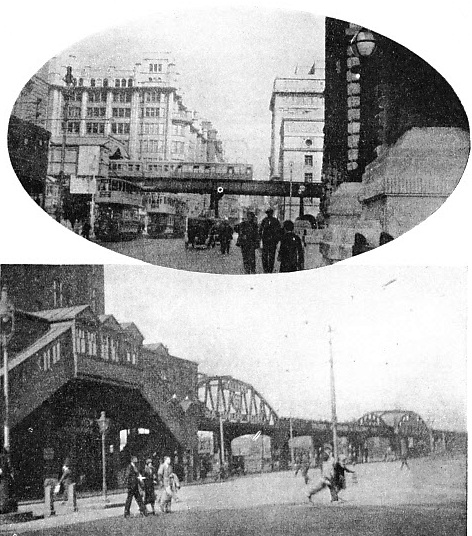
THE STEEL FRAMEWORK of the Liverpool Overhead Railway carries the lines some 16 ft above the road. This picture gives a good impression of how the track crosses busy thoroughfares. The Liverpool Overhead Railway was opened for traffic in 1893. It was the first overhead electric railway in the world, and the first electric railway of industrial importance in the United Kingdom.
Except for the New York Elevated, we have so far been considering railways that are above ground for only part of their length. Unique in that it traverses a great city and runs above ground for its entire length is the Liverpool Overhead Railway, the initial section of which was opened for traffic in 1893. This line was electrically operated from the start, and was the first overhead electric railway in the world. It was the first electric railway of commercial importance in the United Kingdom, although the Brighton Electric and the Giant’s Causeway and Portrush lines were opened ten years earlier.
The reason for this railway, which is six and a half miles in length and was a pioneer in the use of automatic signalling, was the Liverpool dock system. The line follows the west bank of the Mersey, and fifteen out of its sixteen stations serve the docks. The system was not originally promoted by a railway company, but took over Parliamentary powers first granted to the Mersey Docks and Harbour Board under two Overhead Railway Acts. A spur line was built in 1905 to permit of through working to and from the then Lancashire and Yorkshire’s Liverpool, Southport and Crossens electrified line, and such a service was regularly provided until 1922, when it was withdrawn owing to road competition. But once a year, on Grand National Day, a special through service is still maintained by the Liverpool Overhead to and from Aintree.
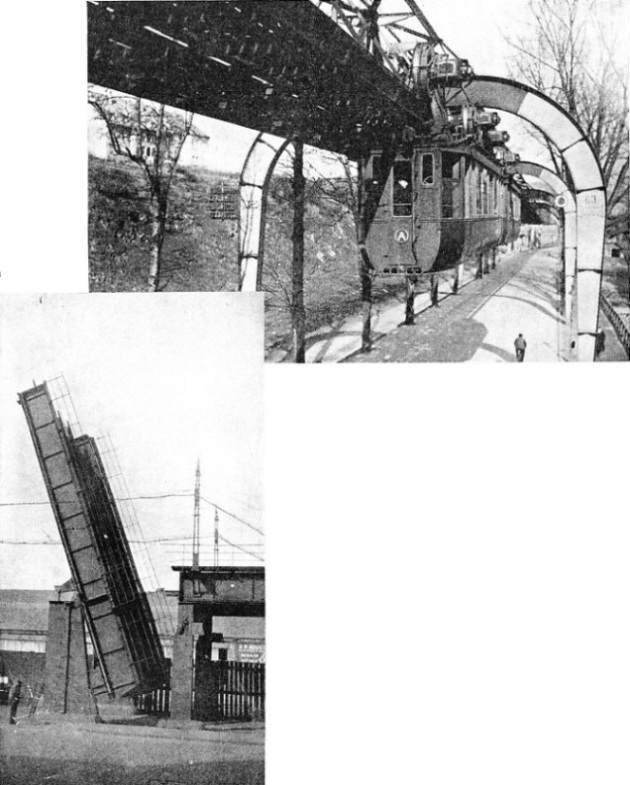 ABOVE A PUBLIC HIGHWAY. Although most of the Barmen-
ABOVE A PUBLIC HIGHWAY. Although most of the Barmen-
A TILT BRIDGE on the Liverpool Overhead Railway. At some points movable bridges over the docks have been built to give passage to the shipping that is continually passing in and out of the port.
Overhead railways may be divided into two classes: those in which the ordinary methods of building and track construction are employed, and those involving the use of a specialized form of track work. In the second category was the little Listowel and Ballybunion Railway, in Ireland, a pioneer among monorail systems. This line, which had a length of ten and a quarter miles, was not very successful, and ceased working in 1924. The monorail system employed was that of Lartigue, in which the main or running rail was carried on a series of trestle-
The Listowel and Ballybunion Railway was a cross between the surface line and the elevated railway proper, since its clearance above road level was much lower than that of the overhead systems described above. It may also be regarded as an intermediary between the orthodox method of rolling-
This line is carried well above street level, and crosses a river. The cars are slung from electrically-
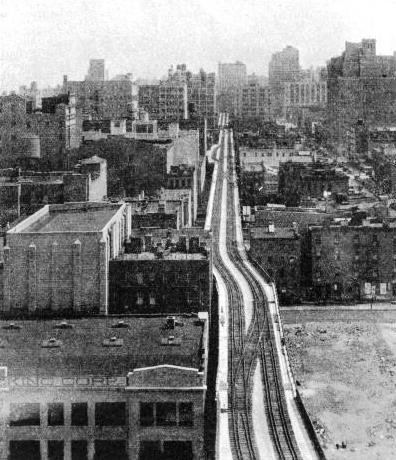 The elevated railway and the monorail largely go together, but when it comes to the monorail designed for very high speeds, progress to date has been more in the form of plans and models than in realization. Louis Brennan, better known in connexion with torpedoes, in 1907 demonstrated on his lawn a gyroscopic car running on a single line of rail, and needing no guide rails to support it. The vehicle was also able to travel on an even keel when running on a loosely supported cable. The principle of the gyroscope is that if a flywheel is mounted on a vertical shaft and caused to revolve at very high speed, it will defy every attempt to force the axis out of the perpendicular. A somewhat similar vehicle was exhibited two years later by a German, August Scherl. But both Brennan and Scherl were before their time, and the idea languished for want of support.
The elevated railway and the monorail largely go together, but when it comes to the monorail designed for very high speeds, progress to date has been more in the form of plans and models than in realization. Louis Brennan, better known in connexion with torpedoes, in 1907 demonstrated on his lawn a gyroscopic car running on a single line of rail, and needing no guide rails to support it. The vehicle was also able to travel on an even keel when running on a loosely supported cable. The principle of the gyroscope is that if a flywheel is mounted on a vertical shaft and caused to revolve at very high speed, it will defy every attempt to force the axis out of the perpendicular. A somewhat similar vehicle was exhibited two years later by a German, August Scherl. But both Brennan and Scherl were before their time, and the idea languished for want of support.
AN ELEVATED FREIGHT LINE IN NEW YORK. This great railway viaduct carries the track over the streets with a minimum clearance of 14 ft. The track, known as the West Side Line, forming part of a £20,000,000 improvement scheme, carries a large proportion of New York's food and milk supplies. It is owned by the New York Central Lines.
You can read more on “Chicago’s Unique Underground”, “New York’s Life-
“Underground and Overhead Lines” on this website.
